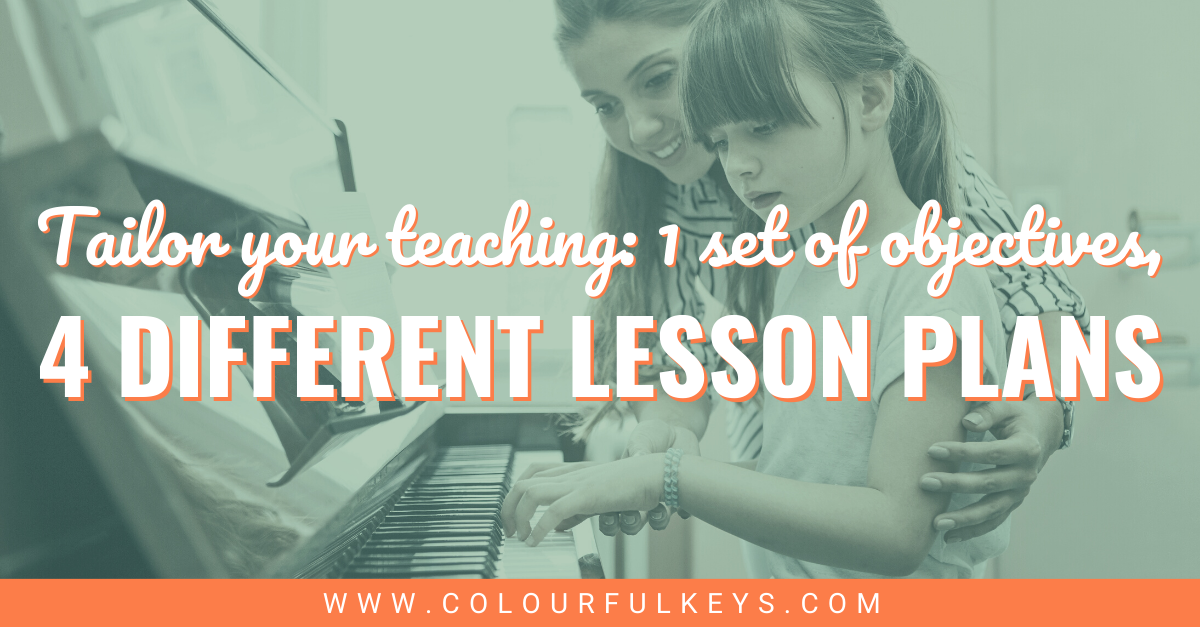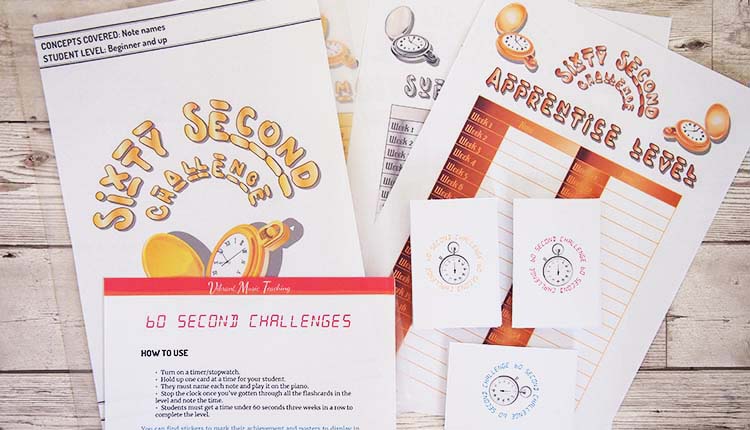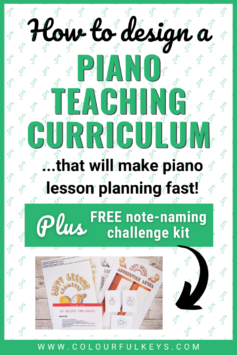
This article about how to tailor your piano lesson plans was written by Chrissy Ricker. Chrissy is a piano teacher, composer, and arranger from North Carolina. She enjoys sharing ideas with other piano teachers and creating music to educate and excite piano students of all ages. When she’s not at the piano, you’ll probably find Chrissy reading a good science fiction novel or spending time with her husband, their dog and two cats. Learn more about Chrissy at her website, chrissyricker.com.
An old saying goes: “If you’ve taught one student, you’ve taught…one student.” Since piano teachers encounter lots of different types of students, customising your lesson plans can feel overwhelming.

One of the challenges of being a teacher is understanding that the things which work to motivate and inspire one student might not work for the next. However, with a little bit of planning and a few easy tweaks, you can tailor your lesson plans to best engage each and every student in your piano studio.
Ways to Customise Your Piano Lesson Plans
So, what tweaks might you make to your curriculum to appeal to different students?
You might find it helpful to add additional material into your standard curriculum. For example:
- Choose a special supplemental book based on your student’s interests
- Add assorted activities such as music apps, improv activities or ensemble opportunities that you know will appeal to your student
- Use manipulatives, flashcards, games and other teaching tools that appeal to your student’s learning style
Or, you might instead adjust how you present the material in your standard curriculum to best engage your student. For example:
- Introduce a new piece by rote instead of jumping right into the score
- Use different vocabulary to explain concepts depending on your student’s interests and learning style
- Look for opportunities to “gamify” review activities or encourage students to think creatively about their current pieces
A Single Piano Lesson Plan, Customised for Four Different Learners
Unfortunately, there is no handbook listing the different types of students you can expect to encounter in your studio. (Wouldn’t that be helpful?!)
However, I’ve compiled an informal list of 4 student personality types I’ve frequently encountered over the years and the teaching approach I have found to be the most effective for each one. How might a single lesson plan differ between these 4 types of learners?
Let’s take this loose lesson plan as an example. In today’s lesson we will:
- Review the C major scale
- Introduce the Classical period style and assign a short Classical piece
- Practise identifying all of the notes on the staff the student has learnt so far
Student No. 1: The Speed Racer
These students love to play fast – the faster, the better, in fact! Who has time for details like dynamics and articulations, anyway?
Fast-Paced, Hands-On and Flashy
“Speed racers” often have short attention spans, so they benefit from lots of short activities to keep them engaged and hands-on at all times.

As you might guess, they love playing fast, flashy music. Pieces that use lots of patterns, and can be taught by rote, are ideal for this type of student.
The Speed Racer’s Lesson Plan
How can we keep the speed racer engaged in their lesson?
- Get them creating music right away by modelling the C major scale, playing hands separately and then both hands in contrary motion. Practising along with a fun drum loop will keep our “speed racer” from playing too fast.
- Listen to an exciting Classical piece, such as Mozart’s “Rondo alla Turca,” as an introduction to the Classical period before we look at their assigned piece for the week.
- Introduce any repeated patterns or tricky rhythms in the new piece by rote and get them playing those right away.
- Finish the lesson with a timed note-naming game. How many notes on the staff can our “speed racer” correctly name and play in 60 seconds?

Subscribe to the newsletter and get the 60 Second Challenges Kit.
Enter your details to subscribe to the newsletter for piano teachers with information, tips and offers.
I hate spam as much as you do! I will only send you emails related directly to piano teaching and you can unsubscribe at any time.
Members can download the 60-second challenge kit in the VMT Library. Colourful Keys is just the tip of the iceberg when it comes to Nicola’s amazing resources. Not a member? If you haven’t heard of the paid-membership side of things, you simply must check it out at vibrantmusicteaching.com. You won’t believe what you’re missing!
Student No. 2: The Social Butterfly
Bubbly and outgoing, the social butterfly often has a full calendar of after-school activities. If given the opportunity, this type of student might spend more of their lesson time chatting about what they did with their friends last weekend than actually playing their pieces.
Familiar, Fun-Loving and Active
“Social butterflies” love familiar music they can play for their friends, like movie themes, pop songs and famous classics.
Since their practice time is often limited by their other activities, these students enjoy having lots of short-term goals to keep them motivated and engaged when they’re at the piano. Consider pairing up your social butterflies to play duets and serve as practice buddies between lessons.
The Social Butterfly’s Lesson Plan
Help your social butterfly focus and connect with the music by tapping into that desire to mingle.
- Your “social butterfly” will probably enjoy learning that the major scale pattern is used in lots of familiar songs, like “Do-Re-Mi” from The Sound of Music and the Christmas favourite, “Joy to the World.”
- After trying out those familiar melodies, create a simple teacher duet part using C, F and G major chords to turn your C major scale practice into a fun ensemble activity.
- Listen to a famous Classical piece your student is sure to recognise (“Rondo alla Turca” would work here too) before looking at the new piece.
- Break their new piece down into several bite-sized chunks so your “social butterfly” will know how to use their practice time efficiently during the week.
- End the lesson by playing a fun board game together to review the notes on the staff, such as Look & Leap from the Vibrant Music Teaching library.
Student No. 3: The Artist
These students enjoy playing lyrical pieces, but often find subjects like technique and theory to be dry and boring. They love pieces that paint a picture or tell a story.
Creative, Sensitive and Imaginative
Engage your “artists” by capturing their imaginations. Create a story to describe what is happening in a piece of music or even to make scale practice more fun.
You might also try finding examples of artwork that capture the mood of a piece your student is learning.

These students often enjoy activities such as adding lyrics to their pieces, creating original artwork to go along with their repertoire or doing theory work with an artistic component, such as colouring notes or drawing on the staff.
The Artist’s Lesson Plan
- Spark their creativity from the start by inviting them to play the C major scale like a variety of animals: a turtle, a bunny, an elephant and a cheetah.
- Go online together to look at some famous paintings from the Classical period. Talk about how the art and architecture of the time influenced music.
- Listen to the new piece before diving into it, and encourage them to create a story to describe what could be happening in the music.
- End the lesson by reviewing notes on the staff using the whiteboard, giving them the opportunity to draw the notes with different coloured markers.
Student No. 4: The Tinkerer
Have you ever had a student who changed the notes in every piece because “it sounds better that way?” If so, you’ve taught a “tinkerer.”
Experimenters and Questioners
These students love experimenting with their pieces and want to know the “why” behind all of those musical rules we have to remember. It can be a challenge to get these students to play faithfully from the score, but encouraging them to think about why the composer made the choices he or she did can help.
Tinkerers love opportunities to analyse and create, so giving them time to improvise, compose and think creatively at every lesson can help to keep them engaged.
The Tinkerer’s Lesson Plan
- Kick off the lesson with an improv activity that gives them a chance to experiment with the C major scale by playing it in different octaves, using the damper pedal, adding harmony and trying different articulations and dynamics.
- Discuss a famous composer from the Classical period and listen to one of their most famous pieces.
- Look at the new piece together and see if they can name the chords and identify any patterns they see in the melody.
- Ask your tinkerer to practise the piece as written this week, and then create their own modified version of it for fun.
- End the lesson by putting flashcards of all the notes on the staff into the correct order. This will give your tinkerer a hands-on activity and challenge their organisational skills.
Want to turn your lesson plans from blah to breathtaking? Check out the resources on Nicola’s Planning Lessons hub page. New ideas are being added all the time!
The Takeaway
Notice that in each of the four scenarios above, we were able to accomplish the same goals with every student. The only differences were (1) how we presented the material and (2) the supplemental activities we chose to best engage each student’s personality type and interests.
By customising our approach, we ended up with four completely different learning experiences. These easy tweaks to tailor the lesson plans made each lesson fresh and exciting for both the piano students and you!

How do you adapt your plans to appeal to different students?
Leave a comment below with your best tips and tricks to tailor your lesson plans to fit different piano students.
I needed this today after teaching 3 siblings who are at about the same level but need different approaches. Thank you!
Also, all my students love your Let’s Quest books!
Thank you so much, Melissa! I am glad these ideas were helpful!